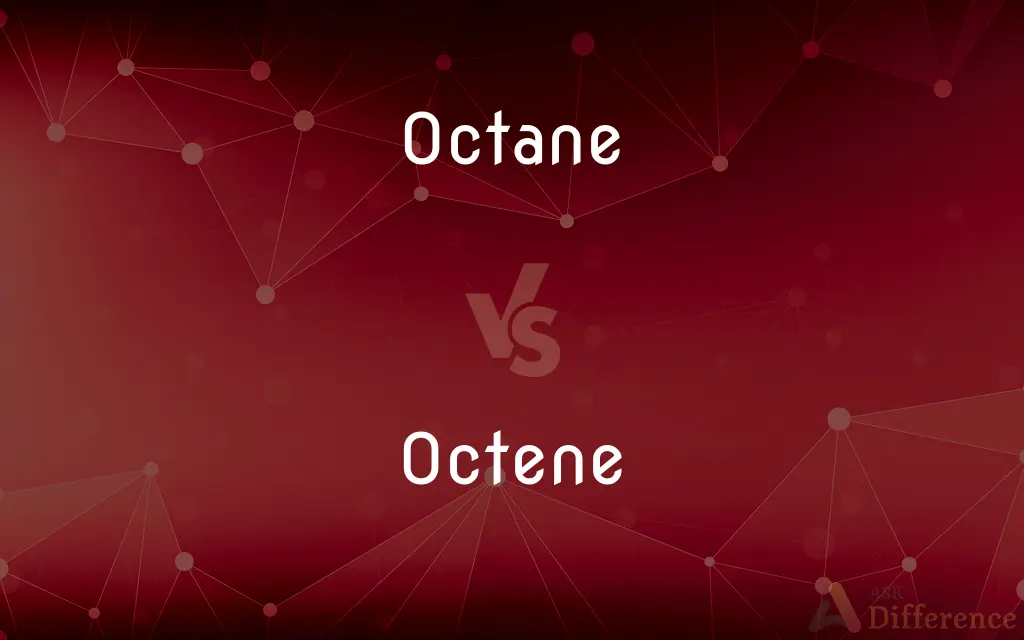Octane vs. Octene — What's the Difference?
By Tayyaba Rehman & Maham Liaqat — Updated on April 20, 2024
Octane is a saturated hydrocarbon with no double bonds, widely used as a standard in fuel rating; octene is an unsaturated hydrocarbon with a double bond, used in polymer production.

Difference Between Octane and Octene
Table of Contents
ADVERTISEMENT
Key Differences
Octane (C8H18) is an alkane, meaning it has a fully saturated carbon chain with single bonds between carbons. On the other hand, octene (C8H16) is an alkene, characterized by having at least one double bond between carbon atoms, which makes it unsaturated.
The presence of a double bond in octene makes it chemically more reactive than octane. While octane is relatively inert due to its saturated nature, octene can participate in a variety of chemical reactions, such as polymerization.
Octane is famously known for its role in the octane rating system, which measures the fuel's ability to resist engine knocking or pinging during combustion. Octene, however, is primarily used in the production of polyethylene, a type of plastic.
In terms of applications, octane is most significant in the context of gasoline and other fuels. Octene’s role is crucial in industrial chemistry, particularly in making plastics and other synthetic materials.
The differences in bonding also imply differences in their physical properties; octane is generally less reactive and has a higher boiling point compared to octene, which has lower stability due to its double bonds.
ADVERTISEMENT
Comparison Chart
Chemical Structure
Saturated (single bonds)
Unsaturated (double bonds)
Reactivity
Low (stable under normal conditions)
Higher (more chemically active)
Main Use
Fuel rating (resistance to knock in engines)
Polymer production (plastic manufacturing)
Presence in Daily Life
Common in gasoline and other fuels
Common in plastic products
Chemical Formula
C8H18
C8H16
Compare with Definitions
Octane
Primary component in gasoline, affecting fuel efficiency.
Higher octane fuels can improve engine performance and reduce knocking.
Octene
More reactive than octane, used in chemical syntheses.
Its double bond allows octene to be polymerized into plastics.
Octane
A saturated hydrocarbon with the chemical formula C8H18.
Octane is used as a reference standard in the octane rating system for fuels.
Octene
An unsaturated hydrocarbon with at least one double bond, formula C8H16.
Octene is crucial in the synthesis of high-density polyethylene.
Octane
Known for its stability and low reactivity.
Octane is valued in fuels for its ability to resist premature combustion.
Octene
Less stable due to its unsaturated nature.
Octene can react with air and light more readily than octane.
Octane
Not used in reactions requiring double bonds.
Unlike octene, octane cannot be used directly in polymerization reactions.
Octene
Found in lighter, less dense oils.
Octene's presence contributes to lower boiling points in crude oil fractions.
Octane
Has a higher boiling point due to its saturated structure.
Octane boils at a higher temperature compared to less saturated hydrocarbons.
Octene
Plays a significant role in the plastics industry.
Polyethylene made from octene is used in containers and pipes.
Octane
Octane is a hydrocarbon and an alkane with the chemical formula C8H18, and the condensed structural formula CH3(CH2)6CH3. Octane has many structural isomers that differ by the amount and location of branching in the carbon chain.
Octene
Octene is an alkene with the formula C8H16. Several isomers of octene are known, depending on the position and the geometry of the double bond in the carbon chain.
Octane
Any of various isomeric alkanes with the formula C8H18, found in petroleum and used as a fuel and solvent.
Octene
(organic compound) Any of many isomeric alkenes having eight carbon atoms and one double bond; some of them are used in the manufacture of polymers
Octane
An octane number.
Octene
Same as Octylene.
Octane
(organic compound) Any of the eighteen isomeric aliphatic hydrocarbons (C8H18) found in petroleum, especially an iso-octane 2,2,4 trimethyl-pentane; they are used as fuels and solvents.
Octane
Octane number
Octane
Any one of a group of metametric hydrocarbons (C8H18) of the methane (paraffin) series. The most important is a colorless, volatile, inflammable liquid, found in petroleum, and a constituent of gasoline or ligroin.
Octane
Any isomeric saturated hydrocarbon found in petroleum and used as a fuel and solvent
Common Curiosities
What is octane primarily used for
Octane is primarily used in fuel applications, particularly to rate fuel's resistance to engine knocking.
How does octene's chemical structure differ from octane
Octene contains at least one double bond between carbon atoms, making it unsaturated, unlike the fully saturated octane.
Why is octene important in industrial applications
Octene is important for manufacturing polymers, especially plastics like high-density polyethylene.
How are octane and octene produced?
Octane and octene are typically produced through the distillation of crude oil, with specific processes adjusted to favor the production of either saturated or unsaturated hydrocarbons.
What environmental impacts are associated with octane and octene?
Both octane and octene are hydrocarbons and can contribute to environmental pollution if not managed properly, particularly during combustion or as part of industrial waste.
Can octane be used in making plastics
No, octane’s saturated structure and lack of double bonds make it unsuitable for polymerization, a key process in plastic production.
How do the reactivities of octane and octene compare
Octene is more reactive due to its double bonds, which are sites for chemical reactions, unlike octane, which is more chemically stable.
What is the significance of octane's boiling point
Octane's higher boiling point, compared to less saturated hydrocarbons, is indicative of its stable and less reactive nature.
What are the physical properties of octane and octene?
Octane is a colorless liquid at room temperature with a higher boiling point due to its saturated structure, whereas octene is also a liquid but more reactive and with a lower boiling point due to its unsaturation.
Why is octene preferred in the production of certain types of plastics?
Octene is preferred for certain plastics due to its ability to create strong and flexible polymers, making it ideal for products requiring durability and resistance to environmental stress.
Are there any health risks associated with octane or octene?
Prolonged exposure to high concentrations of either octane or octene can pose health risks, such as respiratory issues, skin irritation, and other toxic effects.
What advancements have been made in the synthesis of octane and octene?
Advancements in synthesis focus on more efficient, less polluting methods to produce these hydrocarbons, including catalytic processes that enhance yield and reduce by-products.
How does the presence of a double bond affect octene's properties?
The double bond in octene makes it more reactive and provides active sites for chemical reactions, affecting its physical properties like density and boiling point.
What is the role of octane in automotive engines?
In automotive engines, octane helps to prevent engine knocking, which can lead to engine damage, by burning more smoothly under high pressure.
Can octane and octene be found naturally?
Yes, both octane and octene can be found in natural crude oil, though their concentrations and the methods used to extract and refine them vary.
How do the prices of octane and octene compare in the market?
Market prices for octane and octene can vary based on demand, production costs, and their applications in fuels versus polymers, typically with octene being more specialized and possibly pricier.
Share Your Discovery

Previous Comparison
Plausible vs. Probable
Next Comparison
Elusive vs. EvasiveAuthor Spotlight
Written by
Tayyaba RehmanTayyaba Rehman is a distinguished writer, currently serving as a primary contributor to askdifference.com. As a researcher in semantics and etymology, Tayyaba's passion for the complexity of languages and their distinctions has found a perfect home on the platform. Tayyaba delves into the intricacies of language, distinguishing between commonly confused words and phrases, thereby providing clarity for readers worldwide.
Co-written by
Maham Liaqat













































